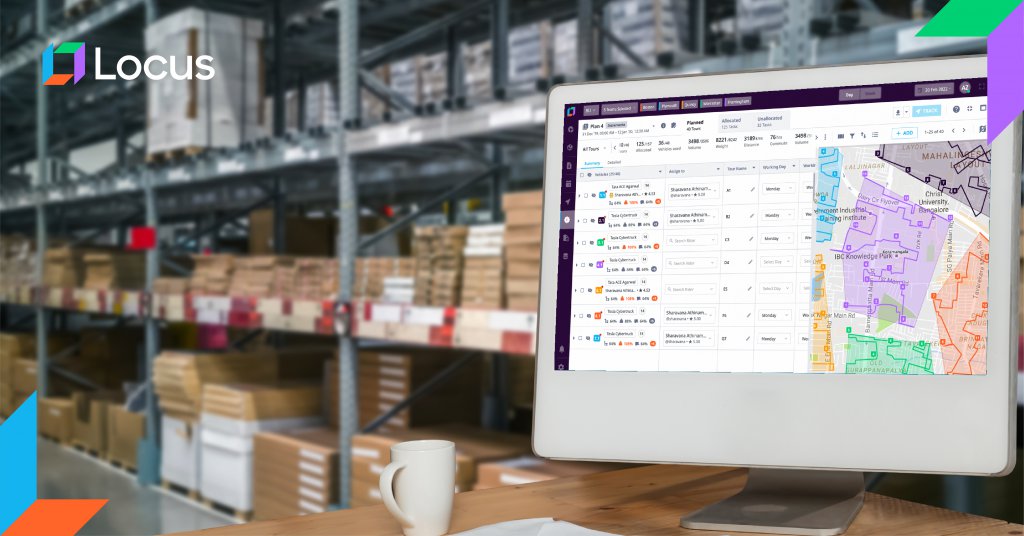The world is evolving to demand ubiquitous delivery of products and services in previously unthinkable schedule windows. Walter Heil, Senior Vice-President of Business, Americas, at Locus, a leader in the logistics space, told us about the problems and pitfalls of tight demand windows – and how last-mile technology providers are paving the way for a more precise future.
The last-mile delivery business is all about having the capability to handle business models that run on tight delivery windows and optimizing the sub-optimal in the real world. Transforming the last mile sector into a growth area of a business should be the end-goal of a company, and behind that goal is improving the customer experience. But what sort of problems are there on the way to delivering that outcome?
The way the world is going, people have been sold the expectation of fast delivery, irrespective of geography or real-world constraints. It doesn’t matter that you live in the countryside, if you’re ordering anything you expect the delivery window to apply to you as it applies to people living in cities.
These days, the service level agreements and consumer expectations are getting steeper. If you order a meal kit, groceries, or any type of food product, you expect those to be delivered in a very narrow window. If they’re not, the whole point of the business is blown. “Some of our e-grocery customers today advertise themselves as 90-minute delivery businesses. You place your order, you have your groceries in 90 minutes, wherever you are,” Walt said.
Enabling efficiencies by tackling real-world constraints
That’s the first problem. Every company is trying to compete with that expectation. An e-grocery business is super sensitive to those tight delivery windows. Any technician, service engineer, or contract janitorial staff that drives their van to an office to install, service, or clean something in the office is on tight expectation schedules – and those schedules change. They could be on schedule, then a new order comes in, and the schedule changes.
Walter told us companies that deliver packages and parcels are under tremendous pressure to be far more efficient in how they utilize their trucks and manage their drivers.
You need to have technology that can manage all of your trucks, drivers, and packages, look at a region or territory and route them, finding optimal routing. ‘Optimal’ here refers to the lowest number of miles but also includes meeting delivery time requirements and maximizing every truck’s capacity.
Companies are trying to reduce the number of overall miles driven and the number of sub-optimal or unfulfilled delivery stops. Walt said, “You don’t want to deliver two packages to the same house within an hour of each other and go back and forth.”

And at the same time, companies are dealing with the pressures of retaining their drivers. Driver wages are going up, so operating costs need to fall to pay drivers competitively. This means empowering drivers with routes optimized for the number of deliveries and miles travelled, all while maintaining existing service level agreements. And the key to success is how you account for the real world in your business model. “A small town has bridges, roads that are too narrow for a large truck to go down. Those are […] real-world constraints,” Walt told us. And smart software & hardware platforms account for several of those real-world constraints. Disruptions in real-time to planned routes mean re-optimizing the sub-optimal in real-time, and that’s a challenge without good technology.
A real-world ready platform solely focused on last-mile excellence
Much of this will be familiar to logistics professionals, and any mature supply company will have a long investment in telemetry to route their vehicles and some form of TMS (transportation management system). Those systems do many different things, including handling freight invoicing, contract rate management, pay and labor scheduling, and much more.
But the Locus platform doesn’t try to replace extant systems, Walt said: “At Locus, we’ve narrowed our focus in the last six to nine months, primarily around routing. Previously, our vision was to digitize specific roles in a business, such as the work of a supply chain officer. But that remit was too broad, and now the company specializes in ensuring excellence in last-mile logistics, right from order capture to delivery.”
Turnkey solutions for end-to-end last-mile logistics optimization at scale
In the North American or European markets with little existing investment in legacy technology like TMS, Locus is a great fit. Still, like much technology today, the capability to integrate with and complement existing Enterprise Resource Planning (ERP) systems is critical. Time is of the essence, and plugging in API-ready solutions that are compliant with diverse regulatory norms go a long way in ensuring competitive advantage at the last-mile in a matter of weeks, not months.
Service providers are also a great fit for the expertise Locus offers. Wherever technicians need to go out and see assets for repair or maintenance, the ability to optimize routes and manage working resources can save huge amounts of cost. Technicians can also complete more tasks at any given day, and still be on time for dinner at home. Even with some form of legacy, Locus is a platform that adds value, Walt said.
Looking to the future
“Say you’re a company with 100 vehicles. You have some telemetry, you have a Google Maps feed from five years ago. At the small scale, with some embedded legacy telemetry, […] our core dispatch and track platform is a turnkey; world-class solution to basically drop in and [manage] end to end.”
Heil reiterated that the Locus technology isn’t predicated on a burn-down-and-start-again approach to deploying technology. “We’re not going to give you a complete heart transplant overnight. We’d start off with routing first, and then gradually we’d roll in our dynamic business. We’re going to hold off on changing your drivers from the app they use to our own version because we don’t want to increase the friction of having two apps at drivers. […] The beauty of our solution is it’s very iterative, it could be rolled out in phases based on functions.”
To learn more about the Locus solution that can revolutionize your last-mile or service business (whatever your turnover), reach out to one of the trained experts at Locus. They know your pain points and likely have a solution for you.









